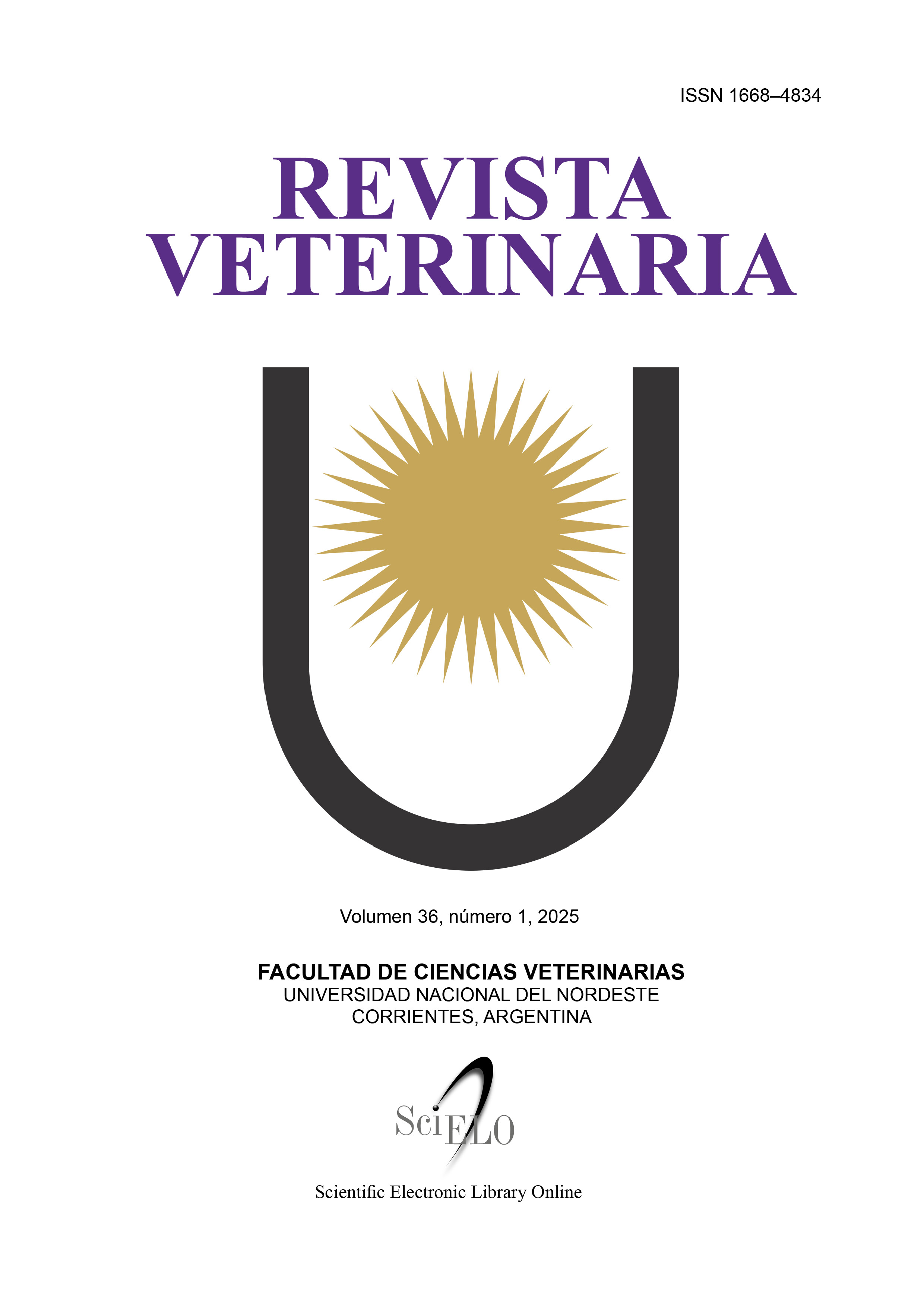Evaluation of parameters associated with seminal quality in llamas (Lama glama) during the pre- and post-mating periods
DOI:
https://doi.org/10.30972/vet.3618158Keywords:
llama, seminal analysis, semen quality, artificial vaginaAbstract
South American camelids (SAC) have gained global relevance due to their productive characteristics, such as meat properties and fiber quality. However, many aspects of their reproductive physiology remain unknown. The llama (Lama glama), a domesticated SAC species raised in the northwestern region of Argentina, exhibits unique seminal characteristics, including ability to form thread of variable length and variability in semen parameters, which may be influenced by environmental, nutritional, and health conditions. The aim of this study was to evaluate parameters associated with semen quality in llamas within their natural habitat during two periods: before and after the mating season. A total of 32 males were evaluated during the pre-mating period (October), with a 56.25% success rate in accepting the artificial vagina (AV). In the post-mating period (April-May), 41 males were evaluated, achieving a 90.25% AV acceptance rate during semen collection (p<0.001). Additionally, the duration of copulation was significantly longer in the pre-mating period (6.33 ± 1.51 min) compared to the post-mating period (4.43 ± 2.27 min; p=0.002). The volume of the liquid fraction of the ejaculate plus foam was also higher in the pre-mating period (8.10 ± 1.9 mL) than in the post-mating period (4.17 ± 0.38 mL; p<0.001). Regarding sperm motility, a trend toward higher motility was observed in the post-mating period. Membrane functionality was significantly higher in the post-mating period (32.28 ± 3.44%) compared to the pre-mating period (22.23 ± 1.71%; p<0.05). Sperm morphology analysis revealed a higher percentage of normal spermatozoa in the pre-mating period (71.66 ± 10.1%) compared to the post-mating period (48.60 ± 2.65%; p<0.001), with abnormalities such as loose heads and tail defects being more prevalent in the post-mating period. These findings provide valuable insights for optimizing reproductive management protocols and improving the productivity of this species.
Downloads
References
Abraham MC, de Verdier K, Båge R, Morrell JM. Semen collection methods in alpacas. Vet. Rec. 2017; 180: 613-614.
Aller JF, Rebuffi GE, Cancino AK, Alberio RH. Influencia de la criopreservacion sobre la movilidad, viabilidad y fertilidad de espermatozoides de llama (Lama glama). Arch. Zootec. 2003; 52: 15-23.
Bertuzzi ML, Fumuso FG, Giuliano SM, Miragaya MH, Gallelli MF, Carretero MI. New protocol to separate llama sperm without enzymatic treatment using Androcoll-ETM. Reprod. Domest. Anim. 2020; 55: 1154-1162.
Bravo PW. Sperm Physiology of South American Camelids. 2023. IntechOpen. doi: 10.5772/intechopen.112876.
Bravo PW, Flores U, Garnica J, Ordoñez C. Collection of semen and artificial insemination of alpacas. Theriogenology. 1997; 47: 619-626.
Bravo PW, Alarcon V, Baca L, Cuba Y, Ordoñez C, Salinas J, Tito F. Semen preservation and artificial insemination in domesticated South American camelids. Anim. Reprod. Sci. 2013; 136: 157-163.
Brown BW. A review on reproduction in South American Camelids. Anim. Reprod. Sci. 2000; 28: 169-195.
Carretero MI, Giuliano SM, Miragaya MH, Neild DM. Male reproductive biotechnologies in South American Camelids Part I: semen collection, evaluation and handling. Anim. Reprod. Sci. 2025a; 272: 107634.
Carretero MI, Neild DM, Bertuzzi ML, Giuliano SM. Male reproductive biotechnologies in South American Camelids Part II: semen dilution, cryopreservation and artificial insemination. Anim. Reprod. Sci. 2025b; 272: 107646.
Casaretto C, Lombardo DM, Giuliano S, Gambarotta M, Carretero MI, Miragaya MH. Morphometric analysis of llama (Lama glama) sperm head. Andrologia. 2012; 44: 424-430.
Casey PJ, Gravance CG, Davis RO, Chabot DD, Liu IKM. Morphometric differences in sperm head dimensions of fertile and subfertile stallions. Theriogenology. 1997; 47: 575-582.
Frank E. Situación actual de los camélidos sudamericanos en Argentina. Proyecto de cooperación técnica en apoyo a la crianza y aprovechamiento de los camélidos sudamericanos en la Región Andina: Food and Agriculture Organization; 2005. http://www.produccion-animal.com.ar/produccion_de_camelidos/camelidos_general/162-situacion.pdf. 2017.
Giuliano S, Ferrari M, Spirito S, Campi S, Director A, Fernández H. Methodological advances on the hypoosmotic swelling test (HOS test) in llama (Lama glama) spermatozoa. Biocell. 2002; 27: 149.
Giuliano S, Director A, Gambarotta M, Trasorras V, Miragaya M. Collection method, season and individual variation on seminal characteristics in the llama (Lama glama). Anim. Reprod. Sci. 2008; 104:359-369.
Giuliano S, Carretero M, Gambarotta M, Neild D, Trasorras V, Pinto M, Miragaya M. Improvement of llama (Lama glama) seminal characteristics using collagenase. Anim. Reprod. Sci. 2010; 118: 98-102.
Hecht BR, Jeyendran RS. The hypo-osmotic swelling test: Is it a sperm vitality or a viability assay? F. S. Sci. 2022; 3: 18-20.
Huanca W. Biotecnologías reproductivas en camélidos sudamericanos domésticos como alternativas para la mejora genética. In XVI Congreso Venezolano de Producción e Industria Animal, Asociación Venezolana de Producción Animal. 2012.
Huanca W, Adams GP. Semen collection and artificial insemination in llamas and alpacas. In: Current Therapy in Large Animal Theriogenology. WB Saunders. 2007. p. 869-873.
Mamani-Linares LW, Gallo C. Effects of supplementary feeding on carcass and meat quality traits of young llamas (Lama glama). Small Rum. Res. 2013; 114: 233-239.
Marcoppido G, Vila B. Manejo de Llamas extra-andinas: Observaciones que contribuyen a su bienestar en un contexto no originario. Revista Argentina de Producción Animal. 2013; 33: 139-154.
Matteucci S. Ecorregión Puna. In: Morello J, Matteucci SD, Rodríguez A, Silvia M, editors. Ecorregiones y Complejos Ecosistémicos Argentinos. 1st ed. Buenos Aires: Orientación Gráfica Editora. 2012; p. 87-127.
Miragaya MH, Chaves MG, Agüero A. Reproductive biotechnology in South American camelids. Small Rum. Res. 2006; 61: 299-310
Morrell JM, Abraham MC. Semen handling in South American camelids: state of the art. Front. Vet. Sci. 2020; 7: 586858.
Miranda-de la Lama GC, Villarroel M. Behavioural biology of South American domestic camelids: An overview from a welfare perspective. Small Rum. Res. 2023; 220: 106918.
Polidori P, Renieri C, Antonini M, Passamonti P, Pucciarelli F. Meat fatty acid composition of llama (Lama glama) reared in the Andean highlands, Meat Science. 2007; 75: 356-358.
Silva M, Paiva L, Ratto MH. Ovulation mechanism in South American Camelids: The active role of β-NGF as the chemical signal eliciting ovulation in llamas and alpacas. Theriogenology. 2020; 150: 280-287.
Tibary A, Vaughan J. Reproductive physiology and infertility in male South American camelids: a review and clinical observations. Small Rum. Res. 2006; 61(2-3): 283-298.
Tibary A, Anouassi A, Sghiri A, Khatir H. Current knowledge and future challenges in camelid reproduction. Soc. Reprod. Fertil Suppl. 2007; 64: 297-313.
Tibary A, Campbell A, Rodriguez JS, Ruiz AJ, Patino C, Ciccarelli M. Investigation of male and female infertility in llamas and alpacas. Reprod. Fertil. Dev. 2021; 33: 20-30.
Vilá B, Arzamendia Y. South American Camelids: their values and contributions to people. Sustain Sci. 2022; 17: 707-724.
Von Baer L, Hellemann C. Variables seminales en llama (Lama glama). Arch. Med. Vet. 1998; 30: 171-176.
Zubair M, Ahmad M, Jamil H. Review on the screening of semen by hypo‐osmotic swelling test. Andrologia. 2015; 47: 744-750.
Downloads
Published
How to Cite
Issue
Section
License

This work is licensed under a Creative Commons Attribution-NonCommercial 4.0 International License.
Revista Veterinaria (Rev. Vet.) maintains a commitment to the policies of Open Access to scientific information, as it considers that both scientific publications as well as research investigations funded by public resources should circulate freely without restrictions. Revista Veterinaria (Rev. Vet.) ratifies the Open Access model in which scientific publications are made freely available at no cost online.











.jpg)
.jpg)



